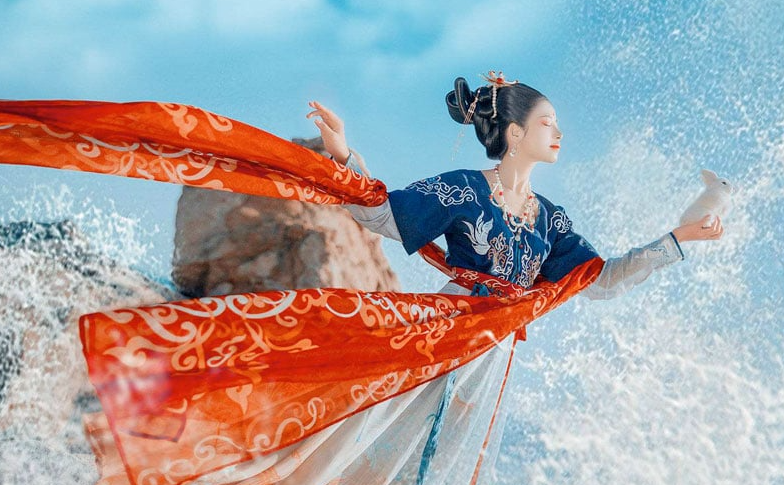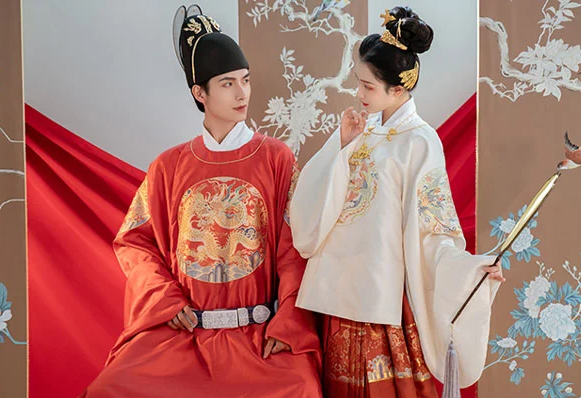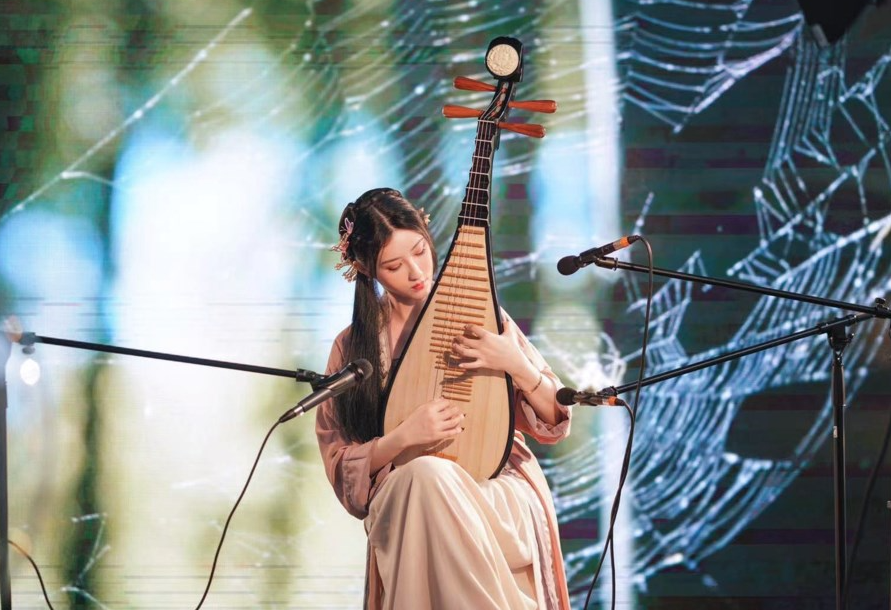Chinese clothing combines rich history, symbolism, and diverse materials.
Historical Development of Chinese Clothing
Ancient Dynastic Clothing
Chinese clothing has a rich history spanning thousands of years. The Hanfu, originated from the Han dynasty, showcases wide sleeves, a cross-collar, and a sash to fasten the attire instead of buttons. Fabrics like silk, hemp, and wool were commonly used. Silk, being a significant Chinese invention, is closely associated with royalty and affluence due to its high cost, which could range from 5 to 10 silver coins per yard in ancient times, and its meticulous production process.
During the Tang dynasty, clothing started embodying more vibrant colors, reflecting prosperity and openness to foreign influences. Notably, women during the Tang era wore blouses and high-waisted skirts which sometimes daringly bared their midriff, a trend quite ahead of its time.

Influence of Various Dynasties
Each dynasty in China brought its own unique style and innovation to clothing, often mirroring the socio-economic and political landscapes of the eras.
- Ming Dynasty: The attire during the Ming dynasty involved round-collared robes and straight lapels, usually made of high-quality silk and often featuring embroidered dragons. These dragons, according to Chinese dragon symbolism, indicated power, authority, and prosperity.
- Qing Dynasty: The Manchu rulers of the Qing dynasty introduced the Qipao (also known as the Cheongsam), which later evolved and became popular worldwide. The classic Qipao features a high neck and a slit on the side, showcasing a blend of modesty and subtle allure. These garments could vary in price significantly based on the quality of silk and craftsmanship involved, ranging from a few dollars to thousands.
- Song Dynasty: The Song dynasty introduced wider and looser clothing, representing a shift toward prioritizing comfort. Women’s clothing especially evolved to accommodate a wide range of activities, including working outdoors, and hence adopted a more practical design.
Evolution through Time
With the transition from feudal society to a more modern era, especially during and after the Cultural Revolution, Chinese clothing underwent drastic changes.
- 20th Century: Western-style clothing started gaining popularity, partially due to the influence of Western countries. During the political turmoil in the first half of the century, practical military-style suits, notably the Mao suit, became widespread.
- 21st Century: Modern China sees a fusion of traditional elements with contemporary fashion. Young designers, maintaining a respect for their cultural heritage, innovate by merging the classic aesthetics of dynastic designs with modern sartorial trends. Nowadays, it’s not uncommon to see fashion runways presenting reimagined Hanfu, stylized Qipaos, or modern attire featuring traditional Chinese embroidery, patterns, and colors.
Iconic Chinese Garments
The Qipao (Cheongsam)
The Qipao, or Cheongsam, became prominent in the 1920s Shanghai and is revered for its elegance and subtlety in design. Initially, it was a loose dress that covered most of the wearer’s body. However, over time, it evolved into a more form-fitting garment that gracefully traces the contours of the body. Traditional Qipaos often feature silk as the primary material, which can cost anywhere from $20 to hundreds per meter depending on the quality, and exhibit delicate patterns such as flowers, birds, and dragons. The Qipao often uses intricate knot buttons instead of zippers, adhering to traditional Chinese craftsmanship. High-end versions might include exquisite embroidery which can push prices to over $1000 per garment.
Hanfu – Traditional Han Chinese Clothing
Hanfu refers to the historical clothing worn by the Han Chinese people. The attire typically consists of a robe or a shirt worn as the upper garment, and a skirt worn as the lower garment, commonly made with comfortable materials such as linen in summer and silk in winter. Hanfu often features wide sleeves and is tied with a sash. The loose structure prioritizes comfort and ease of movement. A full Hanfu set could be priced between $50 for regular wear to $300 or more for sets with intricate designs and higher-quality materials. In the modern era, Hanfu has witnessed a resurgence among young Chinese people as a means to connect with and revitalize their cultural heritage.
Zhongshan Suit (Mao Suit)
The Zhongshan Suit, often referred to in the West as the Mao Suit, became popularized by Sun Yat-sen (also known as Sun Zhongshan) in an attempt to modernize Chinese men’s fashion during the early 20th century. It typically consists of a four-pocket jacket and matching pants, designed to be utilitarian and symbolize equality among the people. The suit saw widespread adoption during the revolutionary periods and later global recognition through figures like Mao Zedong. These suits are traditionally woolen, although cotton versions are also available, with prices ranging from $70 to several hundred dollars.
Tang Suit
Contrary to its name, the Tang Suit doesn’t originate from the Tang dynasty but is rather a modern creation that gained international recognition in the 20th century. Often consisting of a jacket with a standing collar and frog buttons, the Tang Suit blends traditional Chinese elements with Western-style tailoring. Materials often include silk, brocade, and cotton, making the cost variable, ranging from $30 for basic models to several hundreds for luxury designs. The Tang Suit, especially those with exquisite patterns and luxurious materials, often becomes the choice of clothing for international diplomatic events to represent Chinese culture.
Symbolism and Cultural Significance
Colors and Their Meanings
Colors in Chinese clothing are not mere aesthetic choices but are imbued with deep symbolic meanings and associations with philosophical thoughts, like Yin and Yang or the Five Elements Theory.
- Red: A vibrant symbol of luck, prosperity, and joy. Red is a customary color for festive occasions like weddings and New Year celebrations. Brides often wear red to attract good luck and happiness in their marriage.
- Yellow: Historically reserved for the emperor and the royal family, yellow represents power, royalty, and prosperity.
- Blue: Symbolizing immortality and advancement, blue also has associations with spring, wood, and greenery in traditional contexts.
- White: Unlike Western cultures, white typically symbolizes mourning and is traditionally worn at funerals. It represents purity and completeness but is also linked to death and inauspiciousness.
These colors often permeate traditional clothing and play an essential role in portraying cultural narratives and social statuses.
Patterns and Motifs
Patterns and motifs in Chinese traditional clothing go beyond decoration, often conveying wishes, beliefs, and social status.
- Dragons: A symbol of imperial power and authority, often reserved for emperors and high officials, and widely seen on imperial robes. They symbolize strength, nobility, and prosperity.
- Phoenix: Representing femininity and grace, phoenix patterns often adorn bridal wear, symbolizing bliss, harmony, and favorable fortune in marriage.
- Bamboo: Bamboo symbolizes integrity and moral fortitude because it remains upright and survives harsh conditions.
- Peony: Representing wealth, honor, and nobility, peonies are frequent in motifs wishing for prosperity and good fortune.
Motifs often cluster these symbols to convey multifaceted wishes and messages. For example, a peony (wealth) with a dragon (power) might express a wish for prosperous and strong leadership.
Role in Traditional Festivals and Celebrations
Chinese garments shine brightly during traditional festivals and celebrations, embodying cultural essence and aesthetic pursuits.
- Spring Festival (Chinese New Year): Red dominates the clothing color palette during this festival, aligning with the belief that red wards off evil spirits. Clothing often features golden embroidery and vibrant patterns to complement the festive atmosphere.
- Mid-Autumn Festival: Traditional garments like Hanfu and Qipao are popular, with moon-related motifs such as rabbits and Chang’e (the Moon Goddess) often featuring in the designs, symbolizing reunion and harmony.
- Dragon Boat Festival: Duanwu, as it’s known in China, sees less of a particular clothing style, but pouches made of colorful silk, containing herbs to ward off evil, are commonly worn by children.
- Weddings: Red, often combined with gold for additional auspiciousness, is the dominant color. The bride might wear a Qipao or a red veil depending on regional customs, while the groom dons a dark robe, possibly featuring dragon motifs to symbolize power and nobility.
Materials and Fabrication Techniques
Silk Production and Usage
China, heralded as the cradle of silk production, has intertwined its history with silk, permeating through various aspects of its culture and economy. The intricate process of silk production, or sericulture, involves breeding silkworms, primarily Bombyx mori, and then extracting their fibers. Silkworms consume mulberry leaves voraciously for around 30 days before spinning cocoons, which are then boiled to extract silk threads. Harvesting 1 kg of silk involves the boiling of approximately 2,000 to 3,000 cocoons. It can cost around $20 to $50 per yard, contingent upon its quality and type.
Silk threads are famed for their sheen, softness, and natural thermoregulation abilities, making them a sought-after material for garments, particularly in the creation of royal and ceremonial attire. The renowned Silk Road attests to the material’s historical significance and its role in bridging civilizations through trade.

Brocade and Embroidery Techniques
Chinese brocade, recognized for its rich, intricate designs, and luscious texture, has its roots in several regions, each with their distinct styles, such as Yunjin from Nanjing and Shu brocade from Sichuan. Brocade often features motifs like dragons and phoenixes, employing colorful silk threads, and sometimes incorporating gold and silver threads. Producing brocade is labor-intensive, with a skilled weaver creating no more than several centimeters a day, and thus, it is often reserved for elite garments and special occasions.
Embroidery, another pinnacle of Chinese textile arts, showcases various styles across provinces, such as Su (Suzhou), Yue (Guangdong), Shu (Sichuan), and Xiang (Hunan) embroidery. Employing fine silk threads, artisans embroider detailed, colorful designs onto silk or cotton fabrics. For example, Su embroidery is celebrated for its delicacy and vividness, often depicting natural sceneries or animals with a level of detail that they resemble paintings. The cost for hand-embroidered pieces can range significantly from $100 to thousands, determined by complexity and labor hours.
Other Noteworthy Materials
- Cotton: Predominant in northern China due to its adaptability to colder climates, cotton is versatile and widely used for everyday wear. Cotton garments, which might cost from $20 and upwards, provide comfort and durability, ideal for day-to-day activities.
- Linen: Prized for its breathability and lightweight nature, linen sees prevalent use in summer attire. Produced from flax plants, linen garments ensure coolness and comfort during the sweltering summer months.
- Bamboo Fiber: Recognized for its natural antibacterial and moisture-wicking properties, bamboo fiber is not only eco-friendly but also provides superb comfort and is ideal for undergarments and summer wear.
- Wool: Particularly in the colder northern regions, wool plays a pivotal role in garment creation, offering necessary warmth and comfort during the harsh winter months.
Modern Interpretations and Fusion Styles
Contemporary Hanfu Movement
The Hanfu movement, which sparked in the early 2000s, encapsulates a resurgence of traditional Han Chinese clothing, characterized by its cross-collar robe and tied with a sash. Youth and cultural enthusiasts fuel this movement, intertwining traditional aesthetics with modern identities. The price range for a Hanfu can vary drastically, from affordable options around $30 to premium, custom-made pieces exceeding $300 or more, depending on the intricacy and materials used. In metropolitan spaces like Beijing and Shanghai, enthusiasts gather, adorned in various Hanfu styles, bridging temporal gaps and providing a visual feast of ancient aesthetics amid urban landscapes.
The Influence on Modern Fashion Design
Modern Chinese fashion designers are weaving threads of traditional aesthetics into contemporary designs, creating a seamless tapestry that marries historical elegance with modern chic. Guo Pei, for instance, stuns global audiences with her designs that echo imperial grandeur while resonating with modern fashion narratives. Her iconic piece, a lavish gold gown worn by Rihanna at the 2015 Met Gala, took approximately 50,000 hours over two years to complete and comes with a price tag in the hundreds of thousands of dollars, showcasing an epitome of luxury, craftsmanship, and cultural celebration.
Likewise, Uma Wang, another celebrated designer, ingeniously integrates Chinese aesthetics, particularly draping and fluidity from traditional garments, into her globally recognized designs, providing an innovative and soft elegance that speaks to contemporary fashion landscapes.
Fusion with Western Styles
Fusion fashion, blending traditional Chinese elements with Western aesthetics, has been carving a distinctive niche in the global fashion arena. Qipao, with its signature mandarin collar and side slits, finds itself reimagined in myriad forms in modern fashion – from casual wear to high-end couture. The integration of the mandarin collar into shirts, dresses, and jackets, for instance, offers a subtle nod to Chinese aesthetics while maintaining a modern silhouette.
Moreover, fabrics traditionally used in Chinese garments, like silk and brocade, make recurrent appearances in Western fashion. Designers employ Chinese motifs, such as dragons and florals, merging them with Western cuts and styles, thereby crafting garments that are cultural dialogues woven into fabric. These pieces can range widely in price, from high-street brands offering items at around $50, to luxury designers showcasing exclusive pieces that may cost thousands of dollars.

Chinese Clothing in Global Perspective
Exportation of Chinese Textile and Apparel
China stands as a juggernaut in the global textile and apparel industry, contributing significantly to the worldwide distribution of textiles and clothing. The nation exports a substantial array of textile goods, including silk, cotton, wool, and synthetic fibers, catering to diverse international markets. For instance, in 2021, China’s textile exports skyrocketed, reaching approximately 119 billion U.S. dollars, affirming its pivotal role in global textile trade. The country has meticulously cultivated cotton, skillfully bred silkworms, and adeptly harvested silk for millennia, enabling it to mass-produce and export high-quality garments and textile products at competitive prices, which can range from economical to premium across global markets.
Influence on International Fashion
Chinese aesthetics have permeated international fashion, influencing designers and styles across the globe. The opulence of Imperial China, the elegance of Hanfu, and the iconicity of Qipao have inspired numerous western designers. For instance, the likes of Chanel, Dior, and Louis Vuitton have showcased collections that conspicuously echo Chinese elements, such as employing silk brocades, integrating Chinese motifs, and adapting the distinctive silhouettes of traditional garments. This amalgamation of Chinese elements into international fashion has fostered a symbiotic relationship, where cultural exchange flourishes through the medium of fabric and design.
Representation in Global Media and Events
Chinese clothing often graces global media and international events, narrating stories of its rich cultural tapestry to global audiences. The Met Gala, a renowned fashion event, bore witness to an entire theme, “China: Through the Looking Glass,” in 2015, celebrating and exploring Chinese aesthetics’ influence on Western fashion. The exhibit juxtaposed western fashion pieces inspired by China alongside authentic Chinese artifacts and garments, facilitating a dialogue regarding cultural inspiration and appropriation.
In global media, from films to fashion magazines, Chinese clothing often becomes a symbol of exoticism, mystery, and elegance. However, this representation sometimes teeters between appreciation and cultural appropriation, sparking dialogues about respect, understanding, and genuine cultural exchange in global forums. Authentic representation becomes crucial to narrate the rich stories embedded within every thread accurately and respectfully.